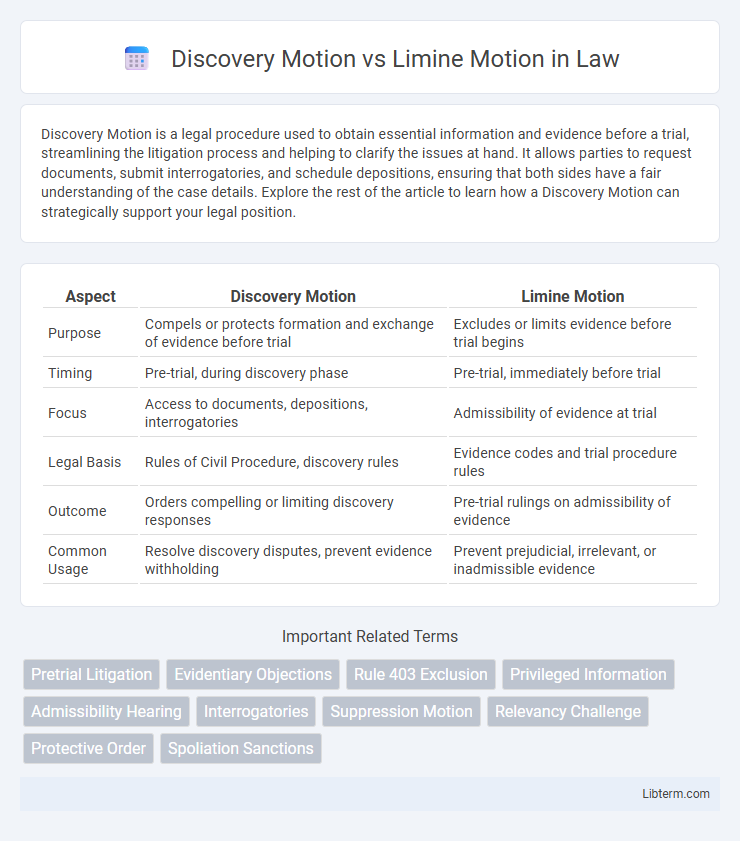Discovery Motion is a legal procedure used to obtain essential information and evidence before a trial, streamlining the litigation process and helping to clarify the issues at hand. It allows parties to request documents, submit interrogatories, and schedule depositions, ensuring that both sides have a fair understanding of the case details. Explore the rest of the article to learn how a Discovery Motion can strategically support your legal position.
Table of Comparison
| Aspect | Discovery Motion | Limine Motion |
|---|---|---|
| Purpose | Compels or protects formation and exchange of evidence before trial | Excludes or limits evidence before trial begins |
| Timing | Pre-trial, during discovery phase | Pre-trial, immediately before trial |
| Focus | Access to documents, depositions, interrogatories | Admissibility of evidence at trial |
| Legal Basis | Rules of Civil Procedure, discovery rules | Evidence codes and trial procedure rules |
| Outcome | Orders compelling or limiting discovery responses | Pre-trial rulings on admissibility of evidence |
| Common Usage | Resolve discovery disputes, prevent evidence withholding | Prevent prejudicial, irrelevant, or inadmissible evidence |
Introduction to Pretrial Motions
Pretrial motions include discovery motions and limine motions, both essential in shaping trial outcomes. Discovery motions address disputes over obtaining evidence, ensuring parties exchange relevant information before trial. Limine motions seek to exclude certain evidence from being presented to the jury, aiming to prevent potential prejudice or irrelevant information during trial proceedings.
Defining Discovery Motions
Discovery motions are legal requests filed to obtain evidence or information from the opposing party during the pre-trial phase, essential for building a case. These motions include interrogatories, requests for production of documents, and depositions, all aimed at uncovering facts and clarifying issues. Defining discovery motions involves understanding their role in compelling disclosure to ensure transparency and prevent surprise at trial.
Understanding Limine Motions
Limine motions are pretrial requests that seek to exclude specific evidence from being presented during a trial, ensuring that inadmissible or prejudicial information does not influence the jury. These motions are distinct from discovery motions, which are primarily used to obtain evidence and information before trial. Understanding limine motions involves recognizing their strategic role in shaping the trial narrative by controlling the admissibility of evidence before it reaches the courtroom.
Key Differences Between Discovery and Limine Motions
Discovery motions are filed during the pre-trial phase to obtain evidence, documents, or information from the opposing party, ensuring thorough case preparation. Limine motions are submitted immediately before or during trial to exclude certain evidence from being presented, aiming to prevent prejudice or inadmissible material. The key difference lies in timing and purpose: discovery motions seek evidence disclosure, while limine motions seek evidence exclusion.
When to File a Discovery Motion
A discovery motion should be filed during the pretrial phase when a party encounters disputes or non-compliance related to the exchange of evidence and information. Courts typically expect discovery motions to be submitted after reasonable attempts to resolve issues informally, but before the discovery deadline expires. Timely filing ensures that motions to compel, protective orders, or other discovery-related disputes are resolved to avoid delays in the litigation process.
Strategic Use of Limine Motions
Limine motions serve as a strategic tool in pretrial practice to exclude potentially prejudicial or irrelevant evidence before it reaches the jury, enhancing trial efficiency and focus. Unlike discovery motions aimed at obtaining information, limine motions carefully shape the evidentiary landscape by preventing damaging disclosures or arguments that could bias the trial outcome. Effective use of limine motions can secure a favorable evidentiary framework, limit surprises, and control the narrative presented to the judge and jury.
Legal Standards for Discovery Motions
Discovery motions are governed by legal standards emphasizing relevance, proportionality, and protection against undue burden under rules like Federal Rule of Civil Procedure 26(b). Courts require parties to demonstrate that requested information is non-privileged, relevant to any party's claim or defense, and proportional to the needs of the case. Limine motions, by contrast, address evidentiary admissibility before trial, focusing on whether evidence meets standards under rules such as Federal Rule of Evidence 403 to avoid unfair prejudice or confusion.
Admissibility Issues Addressed by Limine Motions
Limine motions primarily address the admissibility of evidence before trial, focusing on excluding prejudicial, irrelevant, or improperly obtained information that could unfairly influence the jury. These pretrial motions target specific evidentiary issues such as hearsay, expert testimony limitations, and inflammatory content to ensure a fair trial process. Discovery motions, in contrast, seek to compel the exchange of evidence but do not directly resolve the admissibility of that evidence at trial.
Impact on Trial Preparation and Strategy
Discovery motions play a crucial role in trial preparation by compelling the exchange of evidence and information, allowing attorneys to build a detailed case strategy based on facts and witness statements. Limine motions, filed before trial, strategically exclude certain evidence or testimony to prevent prejudicial or irrelevant information from influencing the jury, shaping the narrative and scope of the trial. Proper use of both motions optimizes trial readiness, with discovery motions clarifying issues and limine motions controlling courtroom dynamics.
Recent Case Law on Discovery and Limine Motions
Recent case law highlights significant distinctions between discovery motions and limine motions in trial preparation. Discovery motions, governed by rules such as Federal Rules of Civil Procedure 26-37, focus on obtaining relevant evidence through depositions, interrogatories, and document requests prior to trial. Limine motions, often addressed under local court rules and evidentiary standards like Federal Rules of Evidence 402-403, seek to exclude or admit specific evidence at trial to prevent unfair prejudice or confusion, as reflected in key decisions like *Ochoa v. G.C. Services Ltd. Partnership* and *United States v. Hicks*.
Discovery Motion Infographic

 libterm.com
libterm.com